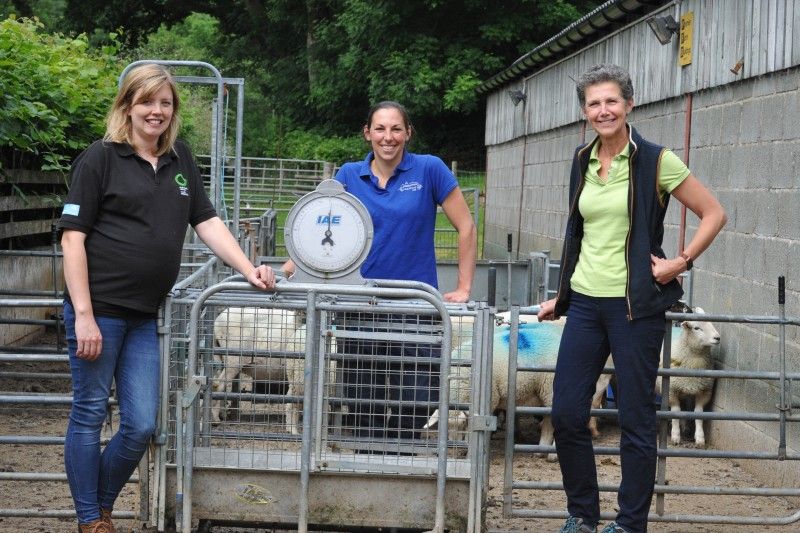
Weaning lambs at 12-14 weeks old will give ewes sufficient time to recover condition on grass before tupping gets underway in flocks this autumn, a sheep expert says.
There is a wide range of weaning ages on sheep farms – in some cases lambs are not removed from their mothers until they are 20 weeks old.
This is not only potentially detrimental to the ewe but to the lamb too because competition for grass and declining milk yield impacts on growth rates.
Independent sheep consultant Kate Phillips, who advises farmers at lamb weaning management events across Wales, says earlier weaning brings benefits to ewes and lambs.
The normal target is to wean by 12-16 weeks but in some years weaning earlier than this, at 10-14 weeks.
She says: “A huge amount can change from year to year according to weather and grass availability but lambs have done a lot better this year so there is no reason why weaning can’t be at 12 weeks.”
Lamb growth rate
From eight weeks of age, the energy intake of lambs is greater from grass than from milk so competition for grass between ewes and lambs reaches a critical point, Ms Phillips says.
Weighing lambs at eight weeks of age and condition scoring ewes will give a good indication of likely weaning dates.
If ewe condition is poor and lamb growth is below target there may be a need to wean earlier.
Lamb growth rate is a good indicator of when to wean so regular weighing is 'essential', she adds.
If lambs on a milk and grass diet are not growing at 200g/day or more it indicates that the ewe is running out of milk, grass supplies are limited or parasites are affecting growth.
Thin, fit and fat
At weaning, sort ewes into groups according to condition – thin, fit and fat - and feed accordingly, giving the thin ewes the best grass, Ms Phillips advises.
For a 70kg lowland ewe, target body condition score (BCS) at weaning is 2.5 and 2 in a 50kg hill ewe. A lowland ewe should at a BCS 3.5 at mating and a hill ewe 2.5.
Ewes need 6-8 weeks to regain one body condition score (BCS), equivalent to 10-13% of bodyweight; that is 7kg for a 60kg ewe, weight that can be gained in 6-8 weeks on good grazing, said Mrs Phillips.
To achieve this from grass and to gain one body condition score, the intake for a lowland ewe needs to be 1.65kgDM/day of 11ME grass; for hill ewes to gain 0.5 BCS, an intake of 0.95kgDM/day of 10 ME grass is needed.
“If you are not going to achieve this, you must consider your stocking rate,” she says.
She recommends culling ewes that are too thin – those below BCS 2 - as they are unlikely to achieve the condition required to perform well in the next production cycle.
“Investigate carefully why they are thin and consult your vet if concerned about disease.”
Ahead of weaning, ensure there is sufficient good quality pasture set aside – in a rotational grazing system grass height should be 10-12cm with a post-grazing residual of 5-7cm.
In a set stocking system, the grass height for weaned lambs needs to be 6-8cm.
To reduce stress on lambs at weaning, leave them in the field where they grazed with their mothers so they are familiar with the water sources and shelter; ensure ewes are out of sight and sound.
'Work with your vet'
Vet Claire Jones, of Milfeddygon Dolgellau Cyf, advises drying off ewes indoors on straw and water for 48 hours or on poorer quality grass to allow milk supply to dry up naturally to minimise mastitis risk.
To prevent problems associated with flies on udders, ensure fleeces are removed promptly and use fly strike pour-on post-shearing.
Monthly faecal egg counting (FEC) will facilitate strategic dosing for worms.
“Monitoring will mean you will know when to dose. Work with your vet to establish which product to use to avoid selecting for resistance,” she says.
Trace element deficiencies should also be addressed before weaning to ensure lambs are making best use of the nutrients in their diet – Ms Jones recommends two weeks before weaning but lambs must be 20kg or heavier if using boluses.
To establish trace element status, she recommends taking blood samples from ewes and lambs or liver biopsies from fat lambs or cull ewes because certain trace elements are stored in the liver which means blood testing doesn’t always give an accurate picture.
With weaning marking the start of the next production cycle, it is important to get it right, said Lisa Roberts, Farming Connect’s Red Meat Technical Officer for Mid Wales.
“A lot of farmers leave lambs on the ewes for too long and don’t think about the consequences for both the ewe and the lamb,” she said.
'Better for income and cashflow'
For hill farmers Berwyn and Helen Roberts, weaning is dictated by harvesting because silage aftermath is needed for lamb grazing.
When weather is poor this impacts on harvesting dates and delays weaning.
An achievable weaning target for their farm is 13-14 weeks because only a small proportion of the farm has high quality grazing, said Mr Roberts.
The farm – Dolobran at Dinas Mawddwy – consists of 93 hectares of hill land, 28 hectares of rough grazing and 16 hectares of better quality land.
It supports a flock of 300 Welsh, crossbred and Romney ewes.
“It would be better for income and cashflow if we could wean earlier but our land doesn’t allow for that, you have to work with what you have,” said Mr Roberts.
